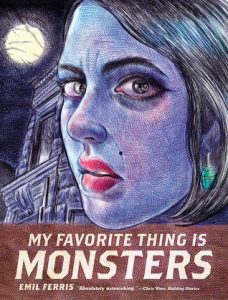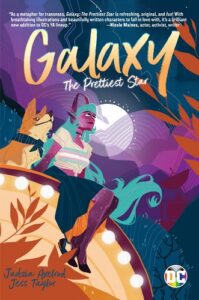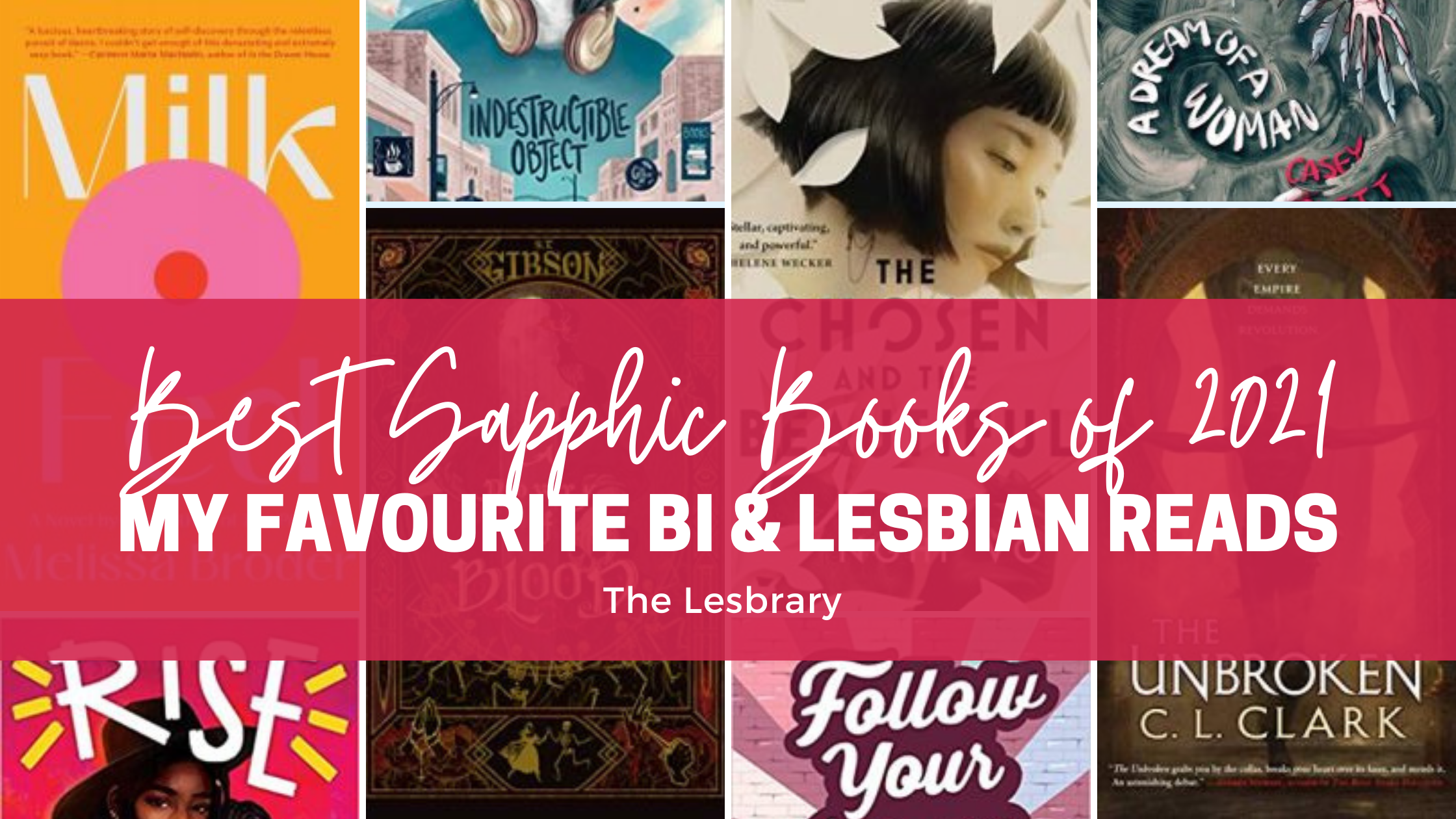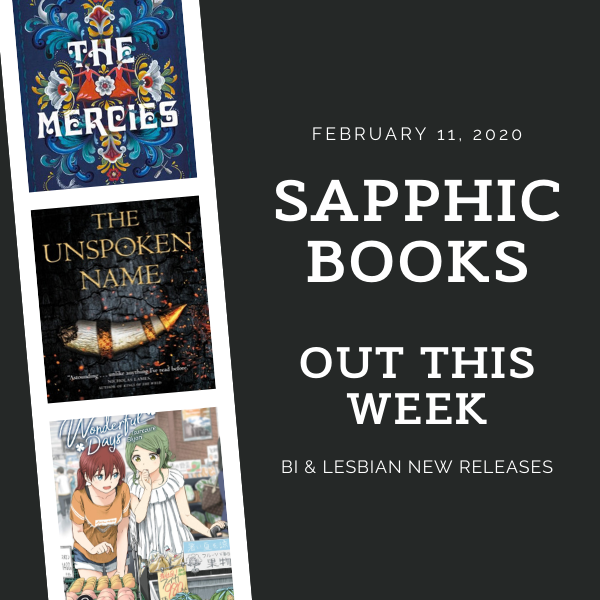Let’s see if I can keep my rhapsodizing to a minimum. Because from the moment I walked into the conference hall, there was a vibrancy in the air. Everyone I encountered during Flame Con was absolutely unabashed in their sheer fannishness, wearing their fandoms on their backpacks, jackets, and jaw-dropping cosplays.
You know you’re in for a good time when the panelists themselves are decked out in geek chic.
PT I – Marginalization, Manga, and More Sapphic Stories
I kicked off my own explorations with a presentation where literary researcher Erica Friedman enthusiastically detailed the history of yuri manga, which was a solid start to the con, because I am hard-pressed to find a single illustrator/animator this side of forty who hasn’t been influenced by or intensely devoured anime and/or manga growing up.
The founder of Yuricon, Friedman has an almost encyclopedic knowledge of the genre, from its early, overly stylized manifestations to the more complex, nuanced stories that have been coming out (pun intended) in recent years. You can learn more details about this interesting, niche history in Friedman’s book By Your Side: The First 100 Years of Yuri Anime and Manga, in which she traces the evolution of the genre from the 1940s to today. The book has all the academic minutiae you’d expect from a seasoned researcher, and all the delightful musings you’d expect from a seasoned fan. A dry text this is not, and if you’ve been put off by the genre for its admitted overreliance on cheesy tropes and “lesbian content without lesbian identity”, Friedman’s book will both contextualize their histories as well as offering recommendations for some of the more innovative, subversive works*.
Speaking of anime and manga, I also stopped by Kat Calamia and Phil Falco’s table in the artist show room. They are the creative team behind one of my favorite sapphic webcomics, Slice of Life. A sort of reverse-isekai**, the plot begins when picture-perfect high school cheerleader Lucy wakes up to a loud scream in the middle of the night. Panicked, she runs into her little sister Ravyn’s room and sees that the protagonist from Ravyn’s favorite anime has come through the TV screen and is now the deuteragonist of her own, less-than-picturesque lesbian identity crisis.
To give Lucy credit, she is the blonde to Yuriko’s brunette. And if that statement confuses you, read Friedman’s book! Then read Slice of Life, because you’ll have a deeper understanding of all the tropes it so entertainingly subverts.
Yuriko’s name also has an interesting historical context. To quote from the Yuricon website: “yuri is Japanese for the lily. Hence…lesbians were yurizoku (百合族), the lily tribe. This name was taken by many hentai manga and doujinshi artists, who then named their lesbian characters “Yuri” or “Yuriko,” so that it became a kind of cliche’ for the genre itself.”
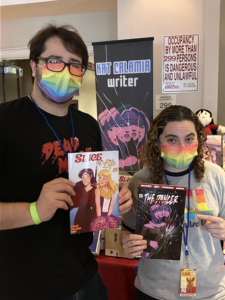
Thankfully, progress has brought the label into the less exploitative mainstream, where it has gone on to encompass interesting manga like Donuts Under a Crescent Moon and clever pastiches like Slice of Life. During our conversation, Calamia mentioned that she is currently working on another, darker project called The Dancer, which focuses more heavily on themes of mental health and has a gorgeous limited edition cover inspired by the iconic film Perfect Blue***. When I asked about her current inspirations, she said that she wasn’t reading anything at the moment, but that she was really enjoying the Netflix show Derry Girls—which isn’t a book, but does have a bookish lesbian in the main cast!
If that sounds up your alley, so might the podcast Bitches on Comics. Book-loving hosts S.E. Fleenor and Sara Century helmed a panel featuring authors Bishakh Som (creator of Spellbound and the intriguing Apsara Engine), Danny Lore (writer for Marvel’s Champions Volume 2: Killer App and DC’s upcoming Multiversity: Teen Justice), Nadia Shammas (writer for Ms. Marvel: Stretched Thin and the excellent Squire), and Tina Horn (author for the NSFW SFSX), the panel touched on how writing characters that shared one’s own marginalized identities can be “a double-edged sword”.
On the good side, it’s great that publishers are willing to back more Black voices. Danny Lore spoke about their experiences growing up with “sci-fi-fantasy [that] always evolved past and away from blackness and brownness, that these idealized cultures were…frankly, bastardized forms of what white folks thought an African-based culture would be.” Growing up with stories written from such limited perspectives led them to try “to pull from a white suburban middle class life that I had never known”, when “I am a New Yorker, my whole life…the world that I grew up in, this Black American world did not, does not exist in a lot of sci-fi.”
But their path through the industry hasn’t exactly been smooth sailing. It’s been hard work, pushing back against publishers’ focus on boxing Black narratives into “trauma stories”. Lore recalls the time they were trying to pitch a manuscript set in the projects in Harlem, and being the only black person there, was subject to a lot of misguided questions about why gentrification was not a bigger theme. It was exasperating because, “I don’t want to tell stories about gentrification. I want to tell stories about people who do magic in the hood.”
Nadia Shammas has had similar experiences with good intentioned and badly informed editors. “When we were pitching Squire, which is a fantasy Middle Eastern world heavily based on the Ottoman Empire and the Byzantine Empire, both of us did an enormous amount of work and put a real place in the book, Petra. But that resulted in publishers going ‘I love this, it’s so brave…do you think that people might think it’s about the real world?’ and ‘People might think it’s about Palestine and we don’t want to make a statement.’”
Which is frustrating, when “as a Palestinian, the way I view the world and therefore the world of my art is going to be painted through that lens, always.”
“The work I make is so personal, and it’s so incredible that people relate to it. But sometimes that means people will then attempt to read more into my work and put things in my mouth that aren’t there.” She acknowledges that “it’s hard to make personal, genuine work when there are outside forces including your employers, who are attempting to use that work to market broadly”.
Which raises the question of whose perspectives are seen as “broadly appealing”. As great as it is to have more inclusivity on the page, it’s important to make sure that the diversity of the characters is reflected behind the scenes, too. As Tina Horn put it, “the difference between all these fictional characters and me is that I’m the one that gets paid. Characters don’t get paid to be in the stories.”
It’s an unfortunate reality that superficial gains can obscure more deeply rooted inequities. For example, the judging panel for the Eisner Awards (the comics industry’s most prestigious award) rarely has more than one person of color. Seriously. Even as the organization makes a more concerted effort to include works by creators of color, the judges themselves are usually not.
Of course, not everyone sets out with the conscious intention of reflecting reality on the page. Sometimes, wonderful art comes from feelings that are indescribable, inarticulable only because the artist has yet to find words or images to express them. So, like Bishakh Som, they create their own.
“I’ve always had a lot of South Asian femmes and women in my work…it just seemed natural, right? Like, why not?” For her, creating comics was less an attempt to break out of a narrow narrative box, and more about building “a sort of gateway or portal into realizing, 50 years later, who I was.”
But that brought its own set of complications. “After coming out like that, I think the burden of representation became a little more explicit and heavy. I think people expected more explicitly trans stories, and I was like, ‘I’m here for that’, but also now I’m going to become this person who writes ‘that kind of thing’.” Not that she minds too much now, “because it’s a cushy and glamorous box” to be in.
PT II – Fanart, Aesthetics and Graphic Novel Illustration
As I like to tell anyone who will listen, comics are such a wonderful medium precisely because the images allow creators to work with metaphors that straddle the line between prose’s staticity and film’s dynamism. So I was excited to chat with Aatmaja Pandya, illustrator for the YA graphic novel Slip, to get more insight on the visual side of the creative process.
When I asked about her inspirations, she was quick to mention Jillian Tamaki. Pandya recalled her time at the New York City School of Visual Arts, where the Eisner-winning artist “basically taught me how to make comics”.
She also mentioned manga as inspiring the “energy and the youthful quality” she brings to her own work. “I think this generation of young cartoonists, or people around my age, all sort of came up in the era of Tokyopop manga…and we’re seeing the consequence of that now. I mean, the ones that I read while making Slip were all Shonen Jump manga, because they have an online app and the subscription is really affordable. So I read, like, all of One Piece.”
Which, at a staggering 1000-odd issues and counting, invited the question: how on Earth did she balance that with making comics and her day job as a high school teacher? Did teaching teens help her develop her art?
“I don’t think it’s influenced my work so much, but it reminds me every day that they are not a monolith. That every person has their own interests and I can’t predict what they’ll be interested in. So to write authentically and to write passionately is what will draw attention.”
When I mentioned her work gave a lot of respect to the depth of young people’s experiences, she thought that was a good way to put it.
“Teenagers feel really complicated feelings and they’re incredibly vulnerable and making a lot of decisions about their future but aren’t given the agency to really be able to control any of it.” She goes on to say that though young readers are not adults yet, “to at least have it acknowledged that what you’re thinking is real to you and serious to you is incredibly valuable, and that’s why I really care about making books about, like, gray areas and complicated, emotional issues for teenagers.”
When asked what comics she read when she was a teenager, Pandya mentioned her fondness for the Fruits Basket manga. “I still reread it every couple of years. But I was such a voracious reader, and we just read whatever was available. So I would read my friends’ volumes and we would all trade stuff. I was just absorbing the aesthetic of it.”
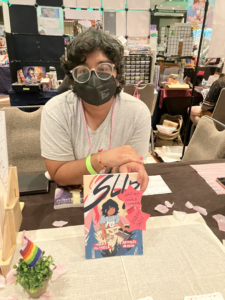
It’s an aesthetic that is more background noise than front-and-present in Pandya’s art style. If you look for it, you’ll see echoes of it in the way certain character’s eyes indicate their emotions, or in the organization of certain panels. Overall, there’s a soft youthfulness to the art and expressions that doesn’t shy away from depicting the characters as the flawed, feeling teenagers they are. And if you end up reading Slip and enjoying Pandey’s illustrations as much as I did, you should know that she has also been contracted for a couple more YA and middle grade graphic novels. Keep your eyes and ears open for more lovely work to come!
I also grabbed a quick convo with Street Noise Books‘ design intern, Dev Kamath. Interns aren’t often front-facing, and the general public is not too aware of their influence on the finished stories, so I hope this spot will shed some light on their efforts. Dev’s passion really came through when I asked what inspired them:
“I personally really enjoy working on queer books, because those are the books I didn’t grow up seeing. And I discovered my identity a lot later because I was finally seeing people around me who were using they/them pronouns. And I was like, ‘Oh, if I saw books like that when I was younger, it would have meant a lot. So I like to do design work and illustrating work and helping other people get their voices out there. Because it’s like, everybody’s got a story to tell. But not everybody has a way to put it out there. I see my role as helping them get there. The current project I’m working on, I’m the one organizing the files and adding the text in and doing some edits to get it to where it can be published easier, so the book gets out faster so people can read it and people want to read it.” (emphasis mine)
That really gets to the heart of it all. At Flame Con, I got a look at the behind-the-scenes efforts, the communities that went into creating these stories and supporting/amplifying the voices that tell them. It’s an intricate, collaborative process, and getting even this superficial glimpse really makes one appreciate the art of it all so much more.
Comics/graphic novels were not the only art form in glorious abundance on the con floor. Painstakingly elaborate cosplays and singularly expressive fandom merch are no scarcity at a con, but this was probably the first one where I’ve so many references to What We Do In The Shadows—or so much slash fanart for sale.
So. Much. Slash. Fanart. And also monster girls, which was neat. What I wouldn’t give for a movie adaptation of Emil Ferris’s My Favorite Thing is Monsters (Book 2 coming later this year!). The metaphors are powerful, and the visuals would lend themselves beautifully to the screen. If you are a fan of the lesbian vampire trope or the bisexual vampire trope or just sapphic horror in general, I strongly recommend it. The story deals with some heavy themes and might not be for everyone, but it certainly pushed boundaries in the sort of way that lends itself to timelessness. It’s a riveting exploration of beauty and relationships and the ways internalized bigotry can shape young self-concepts.
Beauty has long struggled for purchase in comics, though. The American comic imagination has historically been dominated by the ever-more muscled, hyper-masculinized aesthetics of twentieth century Marvel and DC. As exciting as the recent Sandman TV show is, the fact remains that this is (as far as I know) major motion pictures’ first foray into a comic adaptation that is not about a character whose biggest deal is punching (or wanting to punch) various sentient beings in the face with fists or bullets or various elemental beams.
Recent years have thankfully seen a shift in publication trends, though. Creators like the ones I mention above are gaining market share by writing into existence the sort of representation that was once all too scarce. It is a humanizing of the once-monstrous, a reclamation and reconstruction of an art form that has only lately begun to be widely recognized for its merits.
Jadzia Axelrod, the writer for DC’s new(est) sapphic teen extraterrestrial romance shares my hopes for the future of comics. “I mean, the publishing industry is glacial in its movement and the pandemic has only made it slower. I’m not sure how long that sea change will take, but I see on the horizon some projects that I am very excited about. So I’m very hopeful. But we always need more, right?”
“More” including stories that allowed LGBTQ+ people to be messy and make mistakes. “I do think there’s this pressure on queer creators to do queer stories and to also show that queer love is beautiful—which it is—but to also show it as uncomplicated, and it’s just as complicated as straight people’s. And it can be beautiful and complicated and the damaging part is not the queer part, it’s the human part.”
After making that beautifully-worded statement, she recommended Cheer Up: Love and Pompoms by Crystal Frasier. It is a cute high school rom-com about two aspiring cheerleaders who are less worried about coming out and struggling more with what life looks like after the act. It’s my most recent interlibrary loan request, and I await its arrival.
And while we’re on the topic, want to know how you can support libraries in the face of increasing book challenges and bans? Simple: every check-out counts. So, even if you might not necessarily have the time to read them, check out the books about LGBTQ+ experiences, about race, about the histories your high school textbooks glossed over. Even if you are not a budget-conscious grad-student trying to stretch her savings and can afford to buy books, check out the ones you want to support, from creators you want to support. Library purchases make up a not inconsiderable portion of book sales, after all!
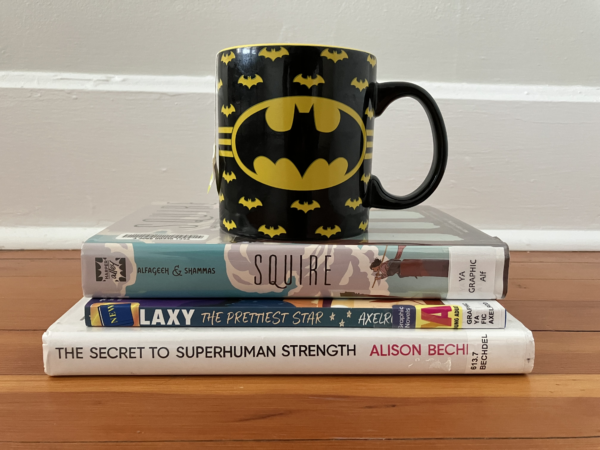
By the end of the weekend, I had a bag full of business cards and an even longer TBR list than before. Attending Flame Con was a great experience that introduced me to so many new creators. It is entirely volunteer-run by fans, for fans, and the ethos of that permeated everything. From the panels to the performances, this was a place where people were able to articulate all aspects of themselves, and the wealth of creativity on display was amazingly affirming to witness. This is a passion project, and one I wholeheartedly enjoyed exploring and learning from.
———-
*Like in I’m In Love with the Villainess, which is a funny, lighthearted isekai** rom-com with a little angst, if you’re looking for more laughs.
**A manga subgenre where people from our world get pulled into fictional ones via portals or reincarnation
***Perfect Blue (1998) by Satoshi Kon, aka “Darren Aronofsky’s Pinterest Board”, as the podcast team at Progressively Horrified calls it. I need to rely less on footnotes, but this was too good a joke to leave out.


